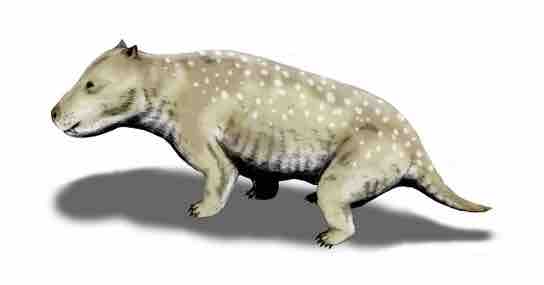Evolution of Mammals
The evolution of mammals passed through many stages since the first appearance of their synapsid ancestors in the late Carboniferous period. Mammals are synapsids: they have a single opening in the skull. They are the only living synapsids as earlier forms became extinct by the Jurassic period. The early, non-mammalian synapsids can be divided into two groups: the pelycosaurs and the therapsids. Within the therapsids, a group called the cynodonts are thought to be the ancestors of mammals . By the mid-Triassic, there were many synapsid species that looked like mammals. The lineage leading to today's mammals split in the Jurassic. Synapsids from this period include Dryolestes (more closely related to extant placentals and marsupials than to monotremes) as well as Ambondro (more closely related to monotremes). Later, the eutherian and metatherian lineages separated. Metatherians are the animals more closely related to the marsupials, while eutherians are those more closely related to the placentals. Eutherians are distinguished from noneutherians by various features of the feet, ankles, jaws, and teeth. One of the major differences between placental and nonplacental eutherians is that placentals lack epipubic bones, which are present in all other fossil and living mammals (marsupials and monotremes).

Cynodonts
Cynodonts, which first appeared in the Late Permian period 260 million years ago, are thought to be the ancestors of modern mammals.
Since Juramaia, the earliest-known eutherian, lived 160 million years ago in the Jurassic, this divergence must have occurred in the same period. After the Cretaceous–Paleogene extinction event wiped out the non-avian dinosaurs (birds are generally regarded as the surviving dinosaurs) and several other mammalian groups, placental and marsupial mammals diversified into many new forms and ecological niches throughout the Paleogene and Neogene, by the end of which all modern orders had appeared.
The synapsid lineage became distinct from the sauropsid lineage in the late Carboniferous period, between 320 and 315 million years ago. The sauropsids are today's reptiles and birds, along with all the extinct animals more closely related to them than to mammals. This does not include the mammal-like reptiles, a group more closely related to the mammals. Throughout the Permian period, the synapsids included the dominant carnivores and several important herbivores. In the subsequent Triassic period, however, a previously-obscure group of sauropsids, the archosaurs, became the dominant vertebrates. The mammaliaforms appeared during this period; their superior sense of smell, backed up by a large brain, facilitated entry into nocturnal niches with less exposure to archosaur predation. The nocturnal lifestyle may have contributed greatly to the development of mammalian traits such as endothermy and hair. Later in the Mesozoic, after theropod dinosaurs replaced rauisuchians as the dominant carnivores, mammals spread into other ecological niches. For example, some became aquatic, some were gliders, and some even fed on juvenile dinosaurs. Most of the evidence consists of fossils. For many years, fossils of Mesozoic mammals and their immediate ancestors were very rare and fragmentary; however, since the mid-1990s, there have been many important new finds, especially in China. The relatively new techniques of molecular phylogenetics have also shed light on some aspects of mammalian evolution by estimating the timing of important divergence points for modern species. When used carefully, these techniques often, but not always, agree with the fossil record. Although mammary glands are a signature feature of modern mammals, little is known about the evolution of lactation. This is because these soft tissues are not often preserved in the fossil record. Most study of the evolution of mammals centers, rather, around the shapes of the teeth, the hardest parts of the tetrapod body. Other much-studied aspects include the evolution of the middle ear bones, erect limb posture, a bony secondary palate, fur and hair, and warm-bloodedness.
A key characteristic of synapsids is endothermy, rather than the ectothermy seen in most other vertebrates. The increased metabolic rate required to internally-modify body temperature went hand-in-hand with changes to certain skeletal structures. The later synapsids, which had more-evolved characteristics unique to mammals, possess cheeks for holding food and heterodont teeth (specialized for chewing by mechanically breaking down food to speed digestion and releasing the energy needed to produce heat). Chewing also requires the ability to chew and breathe at the same time, which is facilitated by the presence of a secondary palate. It separates the area of the mouth where chewing occurs from the area above where respiration occurs, allowing breathing to proceed uninterrupted during chewing. A secondary palate is not found in pelycosaurs, but is present in cynodonts and mammals. The jawbone also shows changes from early synapsids to later ones. The zygomatic arch, or cheekbone, is present in mammals and advanced therapsids such as cynodonts, but is not present in pelycosaurs. The presence of the zygomatic arch suggests the presence of the masseter muscle, which closes the jaw and functions in chewing.